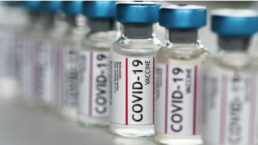World CLL Day - 1 September
World CLL Day - 1 September
Every 1 September, the global CLL community unites to raise awareness about Chronic Lymphocytic Leukemia (CLL) and give those affected by a diagnosis of CLL a much needed voice. On World CLL Day we come together to improve understanding of the vulnerability of CLL patients and the challenges involved in living with CLL.
Access and share WCLLD21 Campaign Materials
You will find a variety of online resources for easy download to promote World CLL Day on your Social Media accounts and other online channels. You can either download specific images by clicking on the image of your choice in the overview below OR you click on the red button below to go to full set of Campaign Materials adjusted for different Social Media channels.
Responses to COVID-19 Vaccines Vary in Patients With Hematologic Malignancies
Responses to COVID-19 Vaccines Vary in Patients With Hematologic Malignancies
This article was originally published on Cancer Therapy Advisor
Patients with hematologic malignancies are known to be at risk of severe outcomes from COVID-19, and experts have recommended prioritizing these patients for COVID-19 vaccination.1,2
However, research has suggested that patients with hematologic malignancies may not mount an effective antibody response to vaccination.3
A study recently published in Cancer Cell provides insight into which hematologic malignancies and anticancer treatments confer a greater risk of poor antibody response, as well as which vaccine may be more likely to produce a response in patients with blood cancers.
To continue reading this article on Cancer Therapy Advisor
The Medicine Gap
The Medicine Gap
Many New Zealanders who try to effect change by advocating for help or medicines support from Pharmac or the Government do so at a very vulnerable time in their lives.
They, or their loved ones are often ill or trying to come to terms with a life-threatening or terminal diagnosis. Often, they are lone voices calling for change or help. Always, it is a David versus Goliath battle.
The Medicine Gap is helping to provide a collective voice to the thousands and thousands of New Zealanders who need help to stay well or to stay alive.
It is our hope that every New Zealander understands the medicines predicament we are in and will join our call to provide First World access to modern medicines for New Zealanders.
– The Medicine Gap
Upcoming CLL events
Upcoming CLL events
International Awareness
Leukaemia and Blood Cancer (LBC) NZ – Blood Cancer Forum
CLLAN Horizons Conference
5 -7 November
Pharmac commits to being more transparent
Priority lists for funding applications
On 28 July for the first time Pharmac released its ‘Options for investment list’. These are the priority medications Pharmac would like to fund if they had the budget to do so. They do not provide a ranking so we don’t know where each medication sits on the list. See the list here.
As a Cancer Patient, Will I Need an Extra Dose of a COVID-19 Vaccine?
As a Cancer Patient, Will I Need an Extra Dose of a COVID-19 Vaccine?
This article was originally posted on Patients Power
Individuals who are immunocompromised, including people with cancer, are wondering if they will need an additional dose of a COVID-19 vaccine to increase their level of protection against the coronavirus. The Advisory Committee on Immunization Practices (ACIP), which makes recommendations to the Centers for Disease Control and Prevention, met on July 22 to discuss this issue, among other topics. The meeting was a preliminary step in discussing the safety and effectiveness of additional vaccine doses before any new recommendations can be made.
When a person has cancer, there are two main reasons why they have an increased risk of infection: Either the disease itself or its treatment may cause suppression of the immune system. When this happens, a person may be considered immunocompromised. It is estimated that close to 3% of the U.S. population is immunocompromised, including those with solid tumors and blood cancers, people who have had organ or stem cell transplants, and those being treated with drugs that affect the immune system, including certain chemotherapy medications and corticosteroids.
While research indicates a very strong response to the COVID-19 vaccines in the general population, there is growing evidence that some people who are immunocompromised have a less robust immune response, even after they have been fully vaccinated.
Let’s review a bit. With rare exceptions, it is vital for everyone with cancer to get a COVID-19 vaccination as soon as they can, including those on most active treatments. Many experts at the ACIP meeting reemphasized the importance of vaccinations for people who are immunocompromised and further pointed out the key role of a “circle of protection” surrounding those who are immunocompromised consisting of other vaccinated individuals. It is important that all household members and others you are in close contact with are vaccinated.
CLL and Dermatology
CLL and Dermatology
Overview
More than a quarter of CLL patients experience skin issues. On Thursday, August 12th, at 2 pm PDT/5 pm EDT, join host Michele Nadeem-Baker and two doctors from The Ohio State University Comprehensive Cancer Center – The James: Jennifer Woyach, MD, hematologist/oncologist, and Brittany Dulmage, MD, a dermatologist specializing in oncodermatology, for a discussion about CLL and skin. How do skin concerns factor into CLL treatment decisions? What role can a dermatologist play on a patient’s care team? Join us for the answers to these questions and more.
Newsletter #13: Submission to Panel Reviewing Pharmac
Newsletter #13: Submission to Panel reviewing Pharmac
Dear Friends
Our major activity over the past month has been engaging with the independent Panel set up by the Government to review Pharmac. In addition to preparing a submission to the Panel, we were able to meet and present our submission to them in person, and we also attended a workshop for patient advocacy groups. See our submission here.
Fellow trustee Dr Ben Schrader, CLL specialist and Malahgan Institute Clinical Director Dr Rob Weinkove and I presented our case to the Panel, and together with the ensuing dialogue we felt it was a valuable and hopefully productive session. The workshop which was attended by all but one member of the Panel and around 16 patient advocacy groups, demonstrated a strong uniformity of depth and breadth of concerns by attendees on the failings of Pharmac regarding funding applications for medical treatment.
The key points we made there and in our submission were as follows:
- Dialogue between Pharmac and agencies making applications for funding is characterised by long delays, lack of feedback as to where a therapy is at in the funding consideration process, and lack of transparency. A much more open approach to dialogue is required.
- There are inefficiencies and blurred responsibilities in the structure and function of Pharmac, eg assessment and procurement need to be done by separate organisations.
- Funding is a major issue, both absolute budget, and the percentage of health budget NZ spends on medications compared to other OECD countries.
- Opinions of NZ consultants and specialist societies are rejected, as are international therapeutic guidelines put together by world authorities. There are examples, too, of the medical literature opinion being rejected as inadequate.
- There are examples of medications being widely available in other countries that are life-saving, and which Pharmac rejects funding thereof. This has resulted in people leaving NZ to get access to these life-saving medications. Case histories of such funding applications to Pharmac are available.
- Lack of funded international standard-of-care treatments in NZ also means we have very few clinical trials, a loss both for patients and clinicians.
- There are mechanisms for assessing how efficacious a drug is eg QALY, which should be a component of Pharmac’s decision process. Another component of non-funding of therapies is that those who can fund medications survive, and those who can’t don’t.
- Several attendees commented on “hidden” costs of treatment not being considered by Pharmac, such as the need to attend a tertiary hospital eg Day Stay Unit for treatment, which might involve long travel times for some people, the need to curtail employment, and the extra challenges that the elderly, disabled, and minorities such as Māori and rural living people face in accessing health care. Cancer Care at the Crossroads is an expansive guide to how oncological services in NZ should be.
- The consequences of successful treatment, such as returning to work as a fully functional member of society needs also to be factored into costs/savings.
- There are international models that function better re drug funding than Pharmac that Pharmac could transition into eg UK (NICE), Canada (CADTH),and Australia (PBAC).
- There have been major improvements in treatment options in oncology particularly over the last decade plus, but Pharmac’s response to these, often expensive, therapies has been anachronistic, and people are dying unnecessarily as a consequence.
- Vacillation has been a feature of serial decisions by Pharmac re grading of funding recommendations for medications. For an example of this see the final page of the submission on the history of Pharmac committee decisions over the past 6 years regarding ibrutinib.
- “Deeply frustrating“ has been an expression used to describe the interaction between funding application agencies and Pharmac.
The Review Panel will present its interim report to the Government on 16 August. We are of course awaiting this with great interest, and I will report to you again as soon as we’ve had an opportunity to digest it.
Best wishes

Neil Graham
Covid-19 Vaccines May Not Produce Sufficient Antibody Response in Transplant Recipients
COVID-19 Story Tip: Covid-19 Vaccines May Not Produce Sufficient Antibody Response in Transplant Recipients
This story was published on John Hopkins Medicine.
When clinical trials were conducted to determine the immunogenicity — the ability to elicit an immune response — for the first two vaccines marshaled against SARS-CoV-2the virus that causes COVID-19, one group was not among those included: people who have received solid organ transplants and others (such as those with autoimmune disorders) who are immunocompromised.
Now, Johns Hopkins Medicine researchers have tried to rectify that inequity, taking one of the first looks at how people who are immunocompromised respond to their first dose of one of the two mRNA vaccines — Moderna and Pfizer-BioNTech — currently being administered worldwide. Their findings, as published March 15, 2021, in a research letter in the Journal of the American Medical Association, disappointingly show that only 17% produced detectable antibodies against the SARS-CoV-2 virus.
“This is in stark contrast to people with healthy immune systems who are vaccinated, nearly all of whom mount a sufficient antibody defense against COVID-19,” says study lead author Brian Boyarsky, M.D., a surgery resident at the Johns Hopkins University School of Medicine.
The study evaluated the vaccine immunogenic response for 436 transplant recipients, none of whom had a prior diagnosis of COVID-19 or tested positively for SARS-CoV-2 antibodies. The median age was 55.9 years and 61% were women. Fifty-two percent were administered a single dose of the Pfizer-BioNTech vaccine and 48% received one shot of the Moderna vaccine. The median time since transplant for the participants was 6.2 years.
At a median time of 20 days after the first dose of vaccine, the researchers report that only 76 of the 436 participants (17%) had detectable antibodies to the SARS-CoV-2 virus. The researchers also found that among the 76 transplant recipients, the most likely to develop an antibody response were those younger than age 60 who did not take anti-metabolites for immunosuppression and who received the Moderna vaccine.
“Given these observations, we feel that the U.S. Centers for Disease Control and Prevention should update their new guidelines for vaccinated individuals to warn immunocompromised people that they still may be susceptible to COVID-19 after vaccination,” says study senior author Dorry Segev, M.D., Ph.D., the Marjory K. and Thomas Pozefsky Professor of Surgery and Epidemiology and director of the Epidemiology Research Group in Organ Transplantation at the Johns Hopkins University School of Medicine. “As the guidelines are currently written, people assume that vaccination means immunity.”
Segev says that upcoming studies will define the immunogenic response of organ transplant recipients and other immunocompromised patients after a second vaccine dose. Other studies will look at the impact of more extensive immune system profiling — including characterizing the immune cells that remember SARS-CoV-2 after vaccination and produce antibodies, or directly attack the virus in response to the presence of the virus — to help guide vaccination strategies for this population.
Boyarsky and Segev are available for interviews.
CLL Advocates Newsletter Issue 12
CLL Advocates Newsletter Issue 12
Dear Friends of CLLANZ
Covid-19 and CLL prevention and treatment – an update.
There is still a lot not known about this disease, but knowledge of it increases daily, and we will know a lot more about what to do to control the disease in coming months.
People who have CLL, and other leukaemias and blood cancers, are much more susceptible to the disease, have more severe disease, are more likely to be hospitalised when they get it, and are more likely to succumb to it than people with normal immune function.
Get vaccinated, if you have CLL.
Vaccination is safer than not being vaccinated – it reduces the severity of the disease, and the mortality rate, even though the vaccination response is reduced (it seems variably and complexly so) in people with CLL.
Herd immunity, nationally and globally, mainly because of vaccination, remains the mainstay of keeping people with CLL safe.
Preventative measures, such as avoiding crowds, social distancing, wearing protective gear such as masks, and washing hands, all remain important measures in preventing disease transmission.
And if you do get it, there seem to be increasingly recognised therapeutic options that can help you. For example, dexamethasone and budesonide save lives, and ibrutinib may reduce the disease severity.
Conversely, some treatments cause immunosuppression, and so increased vulnerability to the disease.
At the moment, in NZ, we have very low rates of the disease, and minimal community transmission, so we’re in a good place to be for staying safe.
This might change if the delta variant becomes established here though – it is more infectious, more likely to need to be treated in hospital, and maybe more resistant to vaccination, especially in the context where a person has only had one dose.
So I hope you all stay well during the pandemic out there in CLL land.
Best wishes

Neil Graham








